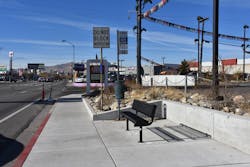A year after EMBARK completed its rebranding process in 2014, which included a new name, colors and logo, a non-rider survey aimed at evaluating public perception revealed 64 percent of residents had heard of EMBARK and 51 percent recognized it as the name of the city’s transit system. When asked how they knew about EMBARK, 63 percent said it was from the bus stops.
“We cannot underestimate the value that those bus stops provide to us,” said EMBARK Administrator/Director Jason Ferbrache. “Whether people use our service or not, they associate that bus stop with our brand and our image.”
While brand image and public perception contribute to a successful transit agency, the value bus stops bring goes beyond these basics and does more than provide a pickup and drop off point. They provide a gateway into the greater transit system which, in turn, creates a lifeline throughout the community.
“Each one of these bus stops is a portal into our system,” explained David Carr, fleet and facilities manager, Regional Transportation Commission (RTC) of Washoe County. “We feel that [upgrading bus stops] enhances our portal and really provides better access for our customer to use our service.”
With bus stops playing an essential role for the system and providing essential access to community services, agencies like EMBARK and RTC must ensure equitable and accessible stops for all.
Infrastructure of Care
Infrastructure, such as shelters and lighting, contribute to a secure bus stop, while additional amenities such as bike racks and trash receptacles improve the rider experience. However, if the sidewalks are too narrow or there are no nearby crosswalks, having nice amenities won’t matter because the stop lacks safe access.
Freddie Fuller, vice president of electronic payment systems at Jacobs and national chair for the Conference of Minority Transportation Officials, says equitable transit is “meeting people where they are.”
Part of this comes down to ensuring infrastructure is accessible for everyone. This means evaluating ADA compliance and addressing pedestrian safety, something both EMBARK and RTC have been doing.
After completing its rebranding, EMBARK began to improve its bus stops primarily by adding shelters since only about five percent of the 1,354 bus stops had them. As part of this process, the board of directors required the agency to only install ADA accessible shelters and adopt a standard design to include a shelter, security lighting, trash receptacle and car corral where necessary. This past fiscal year, Ferbrache challenged his staff to install 100 bus shelters, which the agency completed in July, increasing the number of covered stops by 55 percent.
EMBARK is now working on the MAPS 4 Transit project, an $87-million package that will continue to transform the public transit system throughout the city with new improvements. Of the $87 million, $10 million is allocated for bus stop enhancements that includes installing lighting at every stop and approximately 500 new ADA accessible shelters. And $55 million in additional funding is available through the MAPS 4 Sidewalks, Bike Lanes, Trails and Streetlights program for sidewalks and related amenities/placemaking. This funding will first be distributed to transit and pedestrian priority areas.
“We now have this capital funding source to put in all these sidewalks to connect the shelters that we’re adding through our MAPS 4 Transit money,” Ferbrache said.
RTC has also begun investing in bus stop and sidewalk infrastructure improvements through its ADA Transition Plan that was adopted earlier this year. The commission evaluated more than 300 fixed-route stops and prioritized them based on factors like ridership and ADA deficiency to be upgraded over the next three to five years. This includes the bus pad and the actual bus stop, as well as sidewalk connectivity to the nearest intersection or nearest logical terminus. Sidewalks were a big problem for RTC because they were only 18 inches wide with a light pole in the middle, impeding access to stops, explains Amy Cummings, deputy executive director/planning director, RTC.
“I don’t think we can overemphasize pedestrian safety as a significant issue, especially with regards to equity,” Cummings said. “There’s been so much more research coming out over the last couple of years on how pedestrian safety really is an equity issue in our country and some of those national examples hold true [here]. So, when we’re investing in pedestrian safety, we’re really investing in some of our traditionally underserved communities.”
Improved access to bus stops leads to improved safety, which translates to a better bus stop, says Alva Carrasco, transit and rail market lead, Zero Emissions Bus and Northern California, WSP.
“Let’s take care of our customers, and one of the biggest ways is making them feel safe at the bus stop,” Carrasco said.
Accessible to All Who Want to Access It
Ferbrache describes EMBARK’s vision of equitable transit as “accessible to all who want to access it.” Having ADA-compliant stops with amenities is important but distributing these enhancements throughout the system to provide equal access is just as vital.
“As soon as you start coming outside of [downtown], the amenities start to vanish,” Carrasco said. “So, what you see at the end of each bus route, you won’t necessarily see those amenities match throughout the whole route.”
Ferbrache shares EMBARK has been able to put up new shelters all over the system by primarily using ridership data to help determine which stops would receive shelters. But the agency also considered specific stops that cater to customers that need improved accessibility, such as hospitals, social service locations and neighborhoods that more heavily rely on transit. To this extent, EMBARK has partnered with some specific neighborhoods to help fund the installation of new bus shelters.
“We know through our resident surveys that 25 percent of our community says, ‘Hey, if I could think about the top three things that I think about when I'm considering transit’, covered bus shelters are one of those tops three things,” Ferbrache said. “So that tells us that the discussion we’re having about having high quality bus stops is important.”
Like EMBARK, Cummings explains RTC also looked at income levels, pedestrian safety concerns, census data and the location of essential services.
“Providing that accessibility really opens all those resources up to our full community,” Cummings said.
Are we there yet?
While providing access to vital resources is crucial, considering the actual location of the stop is imperative. As Fuller puts it, “Do we take people where they really need to be?”
On the surface, this may seem like a no brainer. But there are hurdles agencies may face when it is time to install a shelter or create a new bus stop. Fuller and Carrasco explain one hurdle can be the perception of who rides transit and the stigma associated with riders who hail from disadvantaged communities. For instance, Carrasco describes a city that is serviced by the Sacramento Regional Transit District light rail did not want to have increased service or late-night service because residents didn’t want “those people” coming into the city.
“But more good comes out of providing more services than people realize,” Carrasco said. “I think we just have to do a better job in demonstrating that no, crime isn’t going to go up because we now have later service. It’s a lot of these old perceptions that transit riders are bad people and it’s just not true.”
Fuller echoes a similar thought, sharing that a reason transit service may stop short of a job center, like a retail location, may be because of the perception of the riders, which can negatively impact the workers who need to reach this final destination.
“Because Black and Brown people are riding on buses, [people assume] they’re automatically going to come and do something that’s negative,” Fuller said. “So therefore, if I eliminate transit, they can’t get there.”
Despite these hurdles, EMBARK has been having some success in coordinating with private developers and corporate retail locations to provide accessible transit. Ferbrache says two examples that come to mind are the economic development agreement the city has entered with Costco and a new grocery store development opening in a food desert.
“One of the things that kept coming up was, is there access to transit? So, I see that as a success,” Ferbrache said. “And we’ve already had discussions with some of the entities putting that project together about having a robust transit stop at the grocery store.”
RTC has also had success in working with the growing manufacturing and logistics companies in the area, with several of the major employers reaching to RTC “on the front end” before their business is established to ensure future employees can access their jobs, explains Michael Moreno, public affairs manager, RTC, who notes the development community are transit champions for their stakeholders, residents and customers.
“It takes a community to build a strong transit service and program for everyone,” Moreno said.
And a strong transit service that is accessible to all in turn creates a strong, vibrant community.
“Transportation is what makes the world go around,” Fuller said. “If you can provide quality transportation access, you can open up the world to people and give them life.”

Megan Perrero | Editor in Chief
Megan Perrero is a national award-winning B2B journalist and lover of all things transit. Currently, she is the Editor in Chief of Mass Transit magazine, where she develops and leads a multi-channel editorial strategy while reporting on the North American public transit industry.
Prior to her position with Mass Transit, Perrero was the senior communications and external relations specialist for the Shared-Use Mobility Center, where she was responsible for helping develop internal/external communications, plan the National Shared Mobility Summit and manage brand strategy and marketing campaigns.
Perrero serves as the board secretary for Latinos In Transit and is a member of the American Public Transportation Association Marketing and Communications Committee. She holds a bachelor’s degree in multimedia journalism with a concentration in magazine writing and a minor in public relations from Columbia College Chicago.


